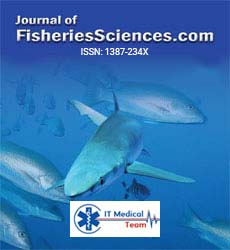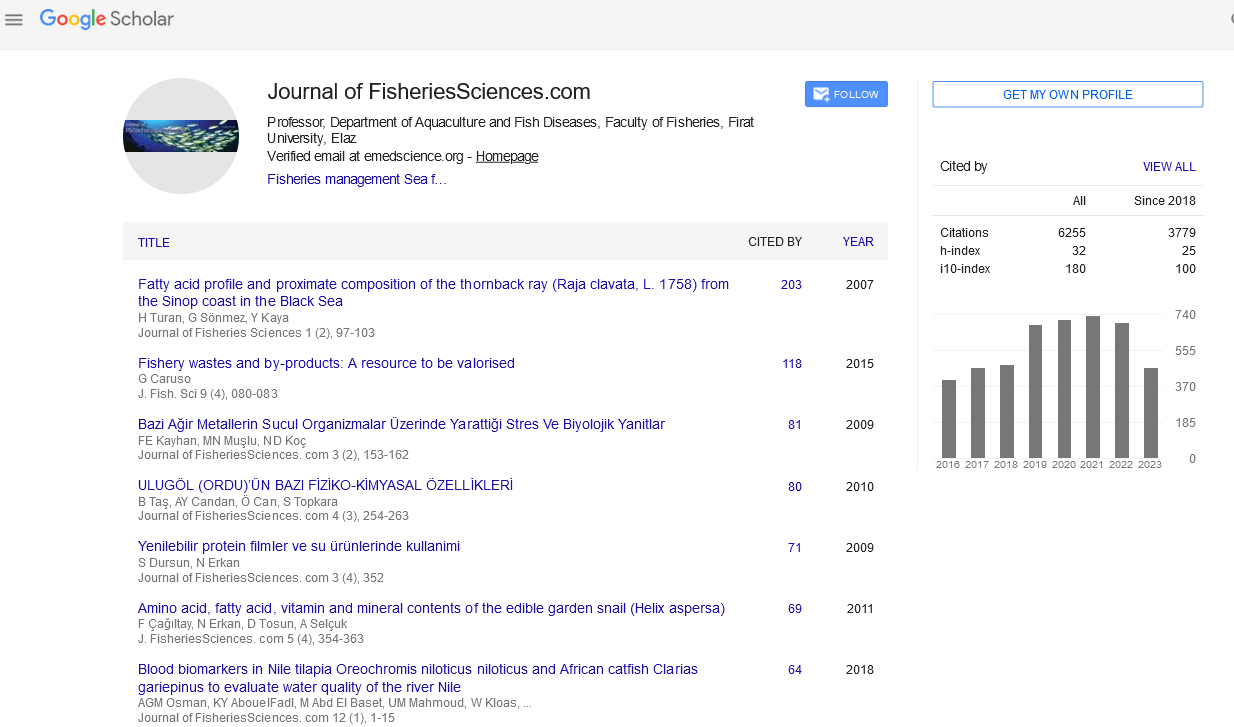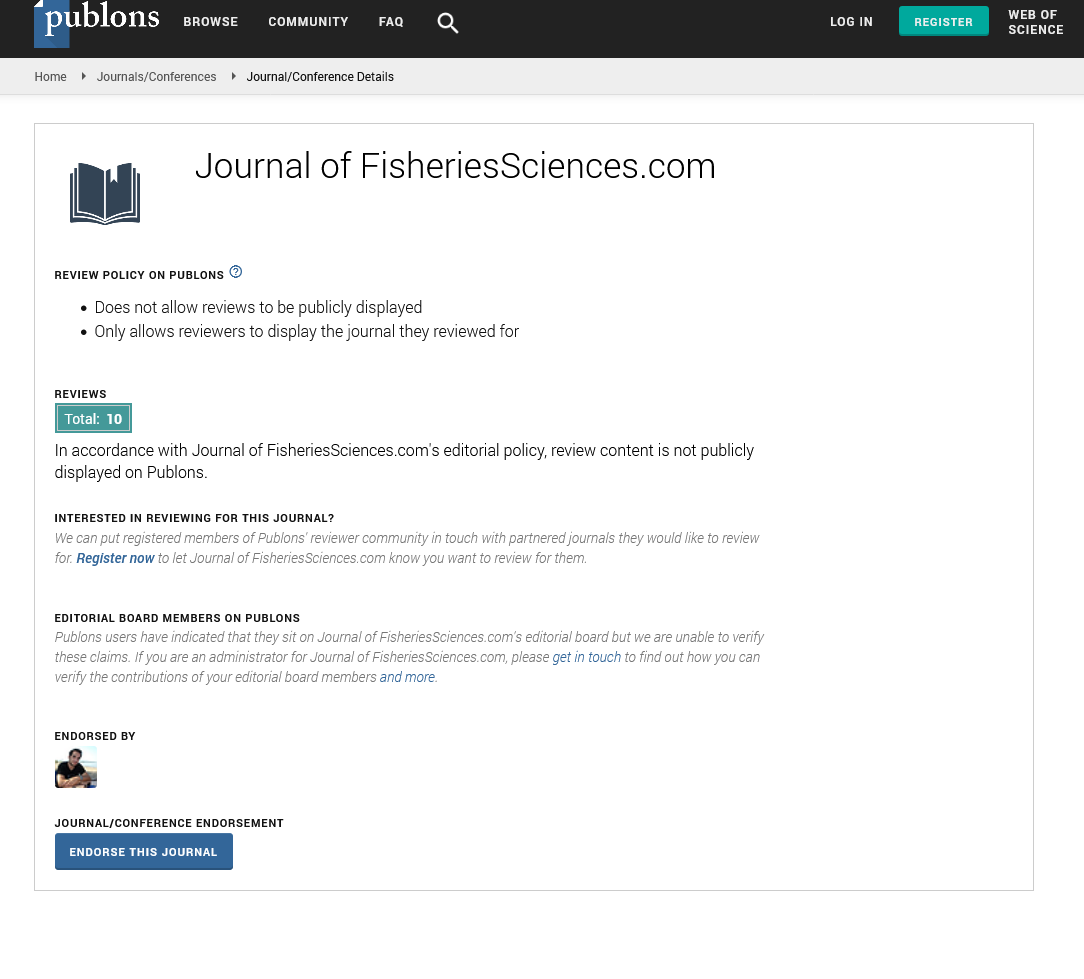Case Report - (2023) Volume 17, Issue 4
The Spread of Fish Species is Regulated via Ecological Characterisation and Specialised Information Systems
Anukool Upaddhyay*
Department of Fisheries, University of Aquaculture and Fisheries, India
*Correspondence:
Anukool Upaddhyay, Department of Fisheries, University of Aquaculture and Fisheries,
India,
Email:
Received: 01-Jul-2023, Manuscript No. ipfs-23-13831;
Editor assigned: 06-Jul-2023, Pre QC No. ipfs-23-13831;
Reviewed: 20-Jul-2023, QC No. ipfs-23-13831;
Revised: 24-Jul-2023, Manuscript No. ipfs-23-13831;
Published:
31-Jul-2023
Abstract
Non-native creatures known as freshwater invasive alien species (IAS)
were mistakenly or purposely discharged into nearby water bodies,
where they disrupted the ecosystem and caused damage to the invaded
habitat. Environmental deoxyribonucleic acid (eDNA) analyses have
been utilised successfully in numerous research over the past few years
to identify IAS. However, efforts to find IAS can be conducted more
quickly and effectively with the aid of geographic information systems
(GIS). In this article, we examine the history of IAS in Southeast Asia
and management initiatives that involved the GIS mapping of known
habitat-specific geographical features. This method makes it easy to
detect and separate regions with IAS habitat traits from those without.
Later, eDNA analysis can be used to validate the presence of IAS in places
where it has been discovered, allowing for additional research and
action. IAS can be used as an indicator to evaluate the environmental
integrity of native rivers in certain places. This combined strategy is
perhaps the first to be used to find freshwater IAS in nearby bodies
of water. Integrating GIS and eDNA into the research of IAS not only
improves the ecology and saves energy and resources, but also helps
residents and authorities manage and take the required enforcement
measures to stop its spread.
Keywords
Invasive alien species; Freshwater management;
Environmental DNA; Geographic information system; Sustainability
INTRODUCTION
In general, nature and humans are interdependent. It is
also possible to think of the interaction between people
and the environment as somewhat mutualistic [1]. The loss
of biodiversity and overexploitation are already having an
adverse effect on freshwater ecosystems. One of the most
harmful factors contributing to the loss in native habitat
populations and the overall biodiversity of freshwater
ecosystems is the presence of invasive species [2]. Invasive
species that are unnecessarily introduced into native habitats
would only exacerbate current problems with freshwater
biodiversity, conservation efforts, and economy, including
biological contamination, ineffective enforcement, habitat
loss, and loss of income, respectively [3].
Anthropogenic activities are the main cause of invasive
alien species (IAS) that are present in local ecosystems
when it comes to non-native freshwater animal species.
Such consequences are particularly noticeable in terrestrial
habitats, where the introduction of non-native species is
more likely to have hazardous repercussions for regional
and global ecosystems and biodiversity due to constrained
geographic borders and natural landscapes [4]. IAS have
been developed locally in several nations, frequently
for uses like food production (aquaculture industries),
collection (ornamental), or recreational fishing [5].
Invasive alien species
Sport fishing is another factor in the spread of IAS into
natural freshwater in Malaysia. A number of non-native
fish, like peacock bass, have been placed into bodies of
water by parties in the hopes that the fish may heighten
anglers' interest in their sport [6]. Due to their ignorance of
the negative impacts of IAS, these parties may initiate IAS.
Whether the release of IAS was intentional or unintended,
it may result in the extensive dispersal and establishment of
alien species in nearby ecosystems [7].
IAS introduction generally has a negative impact on the
overall health of ecosystems and natural habitat areas.
The options for early IAS identification that can be used
in this review were extensively covered, including the
use of eDNA analysis and geospatial analytics using GIS
[8]. In an effort to save local biodiversity in the face of
IAS and other threats, Malaysia joined the Convention
on Biological Diversity (CBD) in 1994. This initiative
encouraged biodiversity protection as a crucial component
of sustainable development. Malaysia is in favour of
a sustainability strategy that promotes environmental
protection while supporting economic expansion. In contrast, the CBD mandates that each party should, to
the maximum extent feasible and as necessary, avoid the
introduction of and control or destroy alien species that
pose harm to ecosystems, habitats, or species [9].
According to the CBD, preventing the establishment of
IAS between and among states is far more effective and
environmentally preferable than taking action once IAS
has already been introduced. If an IAS has been released,
early detection and prompt action are crucial to preventing
its establishment and completely eliminating the organism.
Furthermore, where eradication is not feasible or resources
are not available, containment and long-term monitoring
methods should be put into place. We recommend that
local authorities, particularly for repeat offenders, impose
harsher fines and penalties on individuals who violate the
law and release IAS into local waters [10].
CONCLUSION
It has never been attempted in Malaysia to integrate GIS
mapping specifically for the detection of invasive alien
species (IAS) in freshwater ecosystems, so we strongly
suggested that future studies be conducted to thoroughly
examine this technology from all relevant angles. In
addition, using GIS analysis in conjunction with the
existing trustworthy and effective environmental DNA
(eDNA) analysis will be advantageous for the research of
IAS, as well as for the environment, for cost savings, and
for lowering personnel energy. This technique can therefore
be incorporated into management and surveillance plans
that are pertinent to the early detection of IAS, as well as
into critical management activities that help in supplying
information for important policy decisions by authorities.
The National Action Plan for Prevention, Eradication,
Containment, and Control of Invasive Alien Species, the
Fisheries Act of 1985, the Malaysian Quarantine and
Inspection Services Act of 2011, and other relevant laws
and policies should all be strengthened and enforced fully
in the future, according to our recommendation.
REFERENCES
- Abdul-Muneer PM. Application of microsatellite markers in conservation genetics and fisheries management: recent advances in population structure analysis and conservation strategies. Gen res int. 2014; 2:5.
Indexed at, Google Scholar, Crossref
- Abedi E, Zolgharnein H, Salari MA, et al. Genetic differentiation of narrow-barred Spanish mackerel (Scomberomorus commerson) stocks using microsatellite markers in Persian Gulf. J Agri Environ sci. 2012; 12(10): 1305-1310.
Indexed at, Google Scholar
- Alonzo SH, Ish T, Key M, et al. The importance of incorporating protogynous sex change into stock assessments. Bulletin mar sci. 2008; 83(1):163-179.
Indexed at, Google Scholar
- Antoniou A, Kasapidis P, Kotoulas G, et al. Genetic diversity of Atlantic Bluefin tuna in the Mediterranean Sea: insights from genome-wide SNPs and microsatellites. J bio res. 2017; 24(1): 3.
Indexed at, Google Scholar, Crossref
- Antoro S, Na-Nakorn U, Koedprang W. Study of genetic diversity of orange-spotted grouper, Epinephelus coioides, from Thailand and Indonesia using microsatellite markers. Mar biotech. 2006; 8(1): 17-26.
Indexed at, Google Scholar, Crossref
- Avise JC. Phylogeography: the history and duration of species. Harvard University Press, Cambridge. 2005; 4:34.
Google Scholar
- Bargelloni L, Alarcon JA, Alvarez MC, et al. The Atlantic–Mediterranean transition: discordant genetic patterns in two seabream species, Diplodus puntazzo (Cetti) and Diplodus sargus (L.). Mol phylo Evo. 2005; 36(3): 523-535.
Indexed at, Google Scholar, Crossref
- Beacham TD, Dempson JB. Population structure of Atlantic salmon from the Conne River, Newfoundland as determined from microsatellite DNA. J fish bio. 1998; 52(4): 665-676.
Google Scholar
- Beaumont AR, Hoare K. Genetic considerations in the hatchery. In Biotechnology and Genetics in Fisheries and Aquaculture. Black Sci Oxf. 2003; 56:3.
Google Scholar
- Begg GA, Waldman JR. A holistic approach to fish stock identification. Fish res. 1999; 43(1-3):35-44.
Google Scholar






